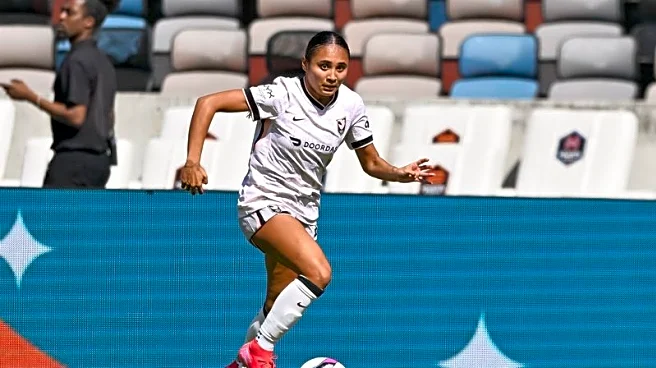What's Happening?
Alex Morgan, a former United States women's national team forward, has expressed confidence in the National Women's Soccer League's (NWSL) ability to attract and retain top talent despite the constraints of a salary cap. In an interview, Morgan highlighted the league's competitiveness as a key factor in drawing both domestic and international players. The NWSL recently saw the transfer of young star Alyssa Thompson to Chelsea, marking a significant move in women's soccer. Morgan, who retired with the San Diego Wave and is now a minority owner, emphasized the league's balance of salaries, facilities, and competition as attractive elements for players. The NWSL's salary cap is set at $3.3 million for 2025, with plans to increase to $5.1 million by 2030 under a new collective bargaining agreement.
Why It's Important?
The NWSL's ability to maintain its competitive edge is crucial for the growth and sustainability of women's soccer in the U.S. The league's structure, including the salary cap, plays a significant role in shaping the financial landscape and competitive balance. As transfer fees in women's soccer rise, the NWSL's approach to player compensation and development will be pivotal in retaining top talent and fostering a robust domestic league. The league's competitiveness not only enhances player development but also boosts its appeal to fans and sponsors, contributing to the overall growth of women's sports.
What's Next?
The NWSL is expected to continue navigating the challenges of balancing financial constraints with the need to attract top talent. As the salary cap increases over the next few years, teams will have more flexibility in player acquisitions and retention. The league's ability to compete with European clubs for top players will be closely watched, as will the impact of rising transfer fees on the global women's soccer market. Stakeholders, including team owners and players, will likely engage in ongoing discussions to ensure the league's competitiveness and financial health.
Beyond the Headlines
The rise in transfer fees and the NWSL's competitive nature highlight broader trends in women's sports, including increased investment and visibility. These developments may lead to more robust youth academies and development programs, further strengthening the pipeline of talent. Additionally, the league's financial strategies could serve as a model for other women's sports leagues seeking to balance growth with sustainability.












